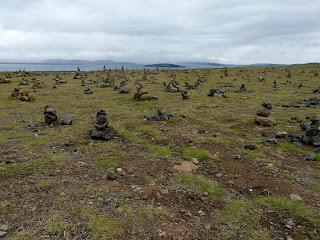Through the middle of the park, and running into the bottom of the large lake, is the seam between the North American and Eurasian crustal plates. The chasm plummets underwater more than 50m, and with a good wetsuit it is possible to swim between two continents.
Even in the fog we went looking for new vantage points, and climbed an extremely steep ( I live in the Rocky Mountains, this road was the steepest I've ever seen!) road up and over a volcanic range. The tops of the mountains were an alien landscape, the road dipped and turned sharply to move between the lava crags. A carpet of tundra grasses and moss clung to the black and red stone.
Descending into the valley again, we saw huge plumes of steam rising into the clouds. We had followed, up and down this mad road, a large grey pipe that snaked and turned over the stones, occasionally dipping underground. We discovered the source - A massive hot springs that supplies all of the hot water for the city of Reykjavik. All the showers, dishwashing, even radiator heating in the city is supplied by this pipe!
Also, we stopped and had a bite and some beers at Ion Hotel. The food was great and the view was amazing from their lounge! Staying there might be a bit rich for many folks, but it's worthwhile to enjoy a cocktail!
We continued around the lake, the clouds rising and falling. The landscape is rolling fields of lava rock, and small pastures and fields, punctuated by steep sloped berms of old flows eroding. This early in the spring it's covered in the otherworldly green moss, and the tough grasses and willows in pale yellow and rust red.
We then came to the space between worlds - Thingviller itself! A river meanders across the broad rift valley and heads for the old church, and the lake beyond. Within an impressive canyon, created by the splitting of the rock instead of the passage of water, a creek flows and then falls to the valley floor. This place was historically the site of the Althing, or great meeting.
 |
| From August 2012, notice how much greener it was! |
 |
| From August 2012, notice how much greener it was! |


























